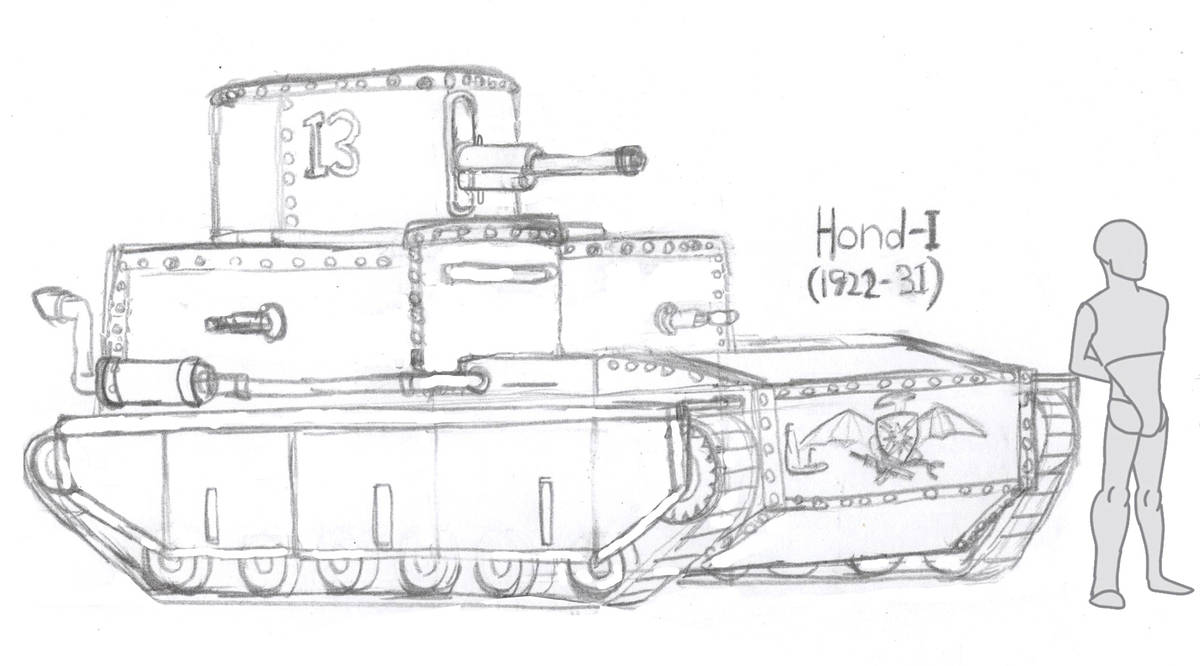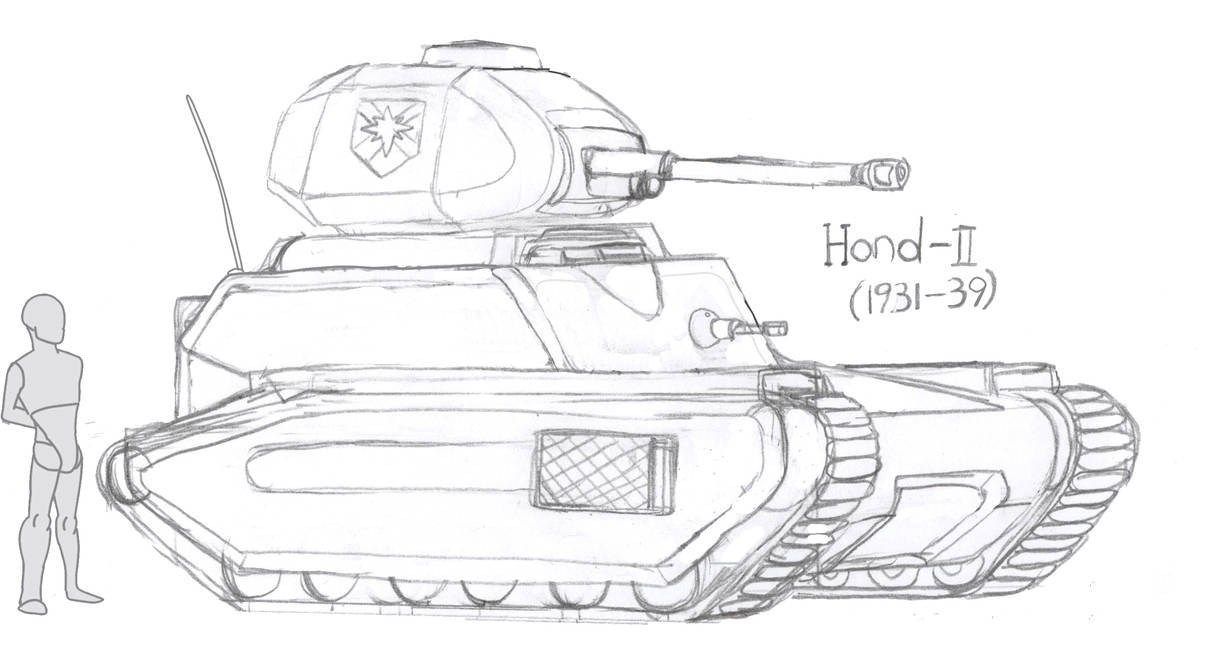
Here we have the three principle models of tanks produced by the Domination of the Draka designed between the Great War and the Eurasian War, which were given the common designation of "Hond" after African hunting dogs.

Hond-I: Developed in the aftermath of WWI, the Hond-I (at the time simply known as the Hond) was conceived of as a middle ground between heavy tanks such as the British Rhomboids (which proved effective in breakthrough campaigns against the Ottomans, but were slow, cumbersome and inflexible) as well as various light tanks (which were more flexible, but faced severe limits due to their small size). The Hond-I had a crew of five and was armed was armed with a 47mm cannon and three Kurenwohr-1916 7.5mm machine guns and with a 76kW Engine could creep along at speeds of up to 25kph. Weighing in at 14 tonnes, it had light armour (6-10mm thick) of riveted steel which was useful against small arms but not much else. The final design had the Engine in the front, which would become standard for Draka tanks. Some 2,700 Hond-Is were built in total, which would spend much of their careers was in the Algerian Standoff, patrolling the land border with the last Non-Draka held part of Africa (who's population included a significant demographic of escaped Serfs), as well as in pacification campaigns in the Middle East and Turkey during the 1920s and early 30s. They were finally withdrawn from service in 1936, with the remaining stock being either scrapped, exported to the Kingdom of Thailand, sold to certain wealthy plantation owners or (in the case of 600 units) given to the Security Directorate who scattered them around various outposts throughout the Police and Military Zones.

Hond-II: The Hond-II was developed after a series of border skirmishes in Algeria and the Soviet Union showed the shortcomings of the Hond-I design. The Hond-2 was meant to address this. It's most notable feature lay in it's armour; following the lead of the French the Ferrous Metals Combine elected for casting it of between 12mm to 50mm. On the one hand this did unquestionably result in hulls which were far more resilient than riveted armour. On the other hand the casting process was both expensive and slow. For it's main armament the Hond-II carried a 65mm cannon backed up by two Kurenwohr machine guns. An improved V-12 engine allowed provided some 250 kW of power to this 27 tonne vehicle, allowing it to crawl along at speeds of up to 40kph. Finally each Hond-II tank was equipped with a Radio (both transmitter and receiver). It's reliability was considerably improved over the Hond-I. Never the less it did have some issues. Most notably the fact that it was just over 3 meters tall, earning it the nicknames of "la Tour" among the French and "Utka" among the Soviets, a larger profile that was harder hide and easier to hit. Some 5,950 Hond-II Tanks would be produced and would make up the Bulk of the Domination's tank forces through the first years of the Eurasian War, though by 1942 the surviving vehicles would remain in second line units. The last 1,000 Hond-IIs produced from late 1937 onward were Hond-II/Bs, which had a slightly enlarged turret an 80mm cannon with an additional 900 older Hond-IIs being upgraded between 38-41. While this did improve overall effectiveness against the newer French AMC 37, Char B4 and SOMUA 39 tanks and Soviet T-31s and VL series tanks, though this involved installing a new turret that was 3 tonnes heavier, had a slower traverse and was very cramped (not that the Hond-II/A's turret was particularly spacious to begin with).
An additional 5,000 Hond-II chassis would be produced for other purposes up until 1941, most notably 2,500 would become Hoplite-I Armoured personnel carriers. Some 1,200 Hond-IIs would be dispatched to the New Confederacy during the Second American Civil War (1939-44), as well as a lot of technical information on it's manufacture and tooling and five upgraded prototypes which were not persued. This (with some adjustments) would become the MT-40 Stonewall tank, the most widely produced tank of the New Confederacy.

Hond-III: In preparation for the invasion of the Soviet Union and Algeria, the high command of the Domination determined that a new generation of tanks would be needed, both powerful enough to match the improving standards of European armour and cost effective to mass produce. Numerous prototypes were produced by various combines, with elements from several of these being put together by the Alexandria Technical Institute to produce what would become the Hond-III. It was massive, weighing in at 46 tonnes and fast, with a top speed of 52kph thanks to it's formidable 560kW engine carried with a modified version of Christie suspension. It was durable with up to 105mm of armour, constructed of welded steel which streamlined the manufacturing process considerably. Finally it was armed with a powerful 90mm cannon as well as a 13mm coaxial machine gun and a 7.5mm machine gun in a forward pintle mount. It took some time for production to fully get into swing, but by 1939 more than a hundred were being made a month. Hond-IIIs were at the tip of the spear during the invasions of French North Africa and Italy in 1940 along with the assault on the Soviet Union in 1941. In total, some 25,600 Hond-IIIs would be produced in factories from Diskarapur to Alexandria them out along with more chassis to be used as Hoplite-II APCs, self-propelled artillery vehicles, Anti-Aircraft vehicles and more. Upgrades would keep it at least competitive with other medium tanks over the course of the War and the Domination even with the emergence of late war competition such as the T-7 Lincoln, FMC F3 Napoleon or the VL-5 Mamont and even with the introduction of the Hond-IV in 1943 it would remain the cornerstone of the Draka armoured legions.
Some 3,100 Hond-IIIs would be exported to the New Confederacy (though about 900 of these would never arrive due to the US Navy interference) where they provided. Efforts by the New Confederacy to begin local production of Hond-III tanks were made, but ultimately the results of which were some 127 vehicle made by three different factories producing their own slightly different copies collectively classified as the HT-43 Davis, but with significant differences between them.
---
This is of course a fanwork version of the Draka.
The Draka belong to SM Stirling.
Zor
Last edited: